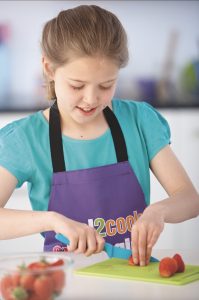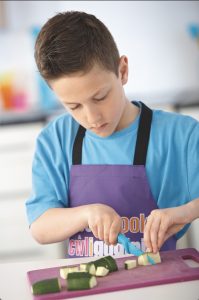
Cooking
Let’s get Ready to Cook
There are some basic rules you should follow before starting to cook
- Tie back long hair.
- Roll up long sleeves.
- Remove all jewellery and nail varnish.
- Wear an apron to protect your clothes.
- Wash your hands before, during and after cooking, especially if you have been handling raw meat.
- Get all your ingredients ready and weighed out these are what you need to make the recipe.
- Wash all fruit and vegetables especially salad ingredients.
- Get all the equipment you need ready before you start.
- Wash sharp items separately – never put sharp knives in the washing up bowl, you might forget they are there and hurt yourself or someone else.
- Walk, don’t run in the kitchen.
- Don’t leave all the washing up until the end! Wash up and wipe the work surfaces as you go along.
- Be careful with sharp knives. If you are not used to using a knife ask a grown up to help you or chop for you, and to teach you the correct and safe way to chop and slice – see below. Young children can grate an onion or carrot instead of chopping it.
- When using a sharp knife use the correct method for the food you are chopping. Ensure the blade of your knife is facing downwards.
Bridge hold
Place the item such as a strawberry on the chopping board. Make a bridge over it with your hand – your fingers should be one side and your thumb on the other side. Guide your knife under the bridge and over the food. Press down and pull the knife along the strawberry, you might like to think of the knife as a train which goes under the bridge! This is suitable to cut things like potatoes, tomatoes and courgettes.

The Claw
To cut the courgette strips or food into chunks use the claw method. Place the food on the board, make a claw with your hand by partly curling your fingers together. Tilt the knife blade downwards and slice through the courgette using your fingers/ claw to hold the courgette. Slide your fingers back keeping a grip on the food, as you slice downwards.

7 – 11 year olds with their increased common sense, ability to follow instructions and dexterity can undertake a wide range of skills.
It will depend on your knowledge of your child, as skills can still vary greatly at this age.
Many children really don’t want to listen to what mummy or daddy say so think safety first and don’t try and tackle anything your feel unsure about.
Activities to try with 7 – 11 year olds
- Weighing – pouring or spooning ingredients into scales. Using measuring spoons
- Washing fruit and vegetables
- Cutting soft ingredients eg butter, mushrooms, strawberries using a strong plastic knife
- Breading and flouring – you can set up three stations with flour, beaten egg and breadcrumbs for fish fingers
- Mixing – using either a spoon or hands to mix together ingredients
- Tearing and squashing – tearing herbs and lettuce or squashing fruit
- Sieving – it’s best to balance the sieve over a bowl and tap it rather than shaking it around!
- Using a pestle and mortar – a light wooden one is better than a heavy one
- Kneading – light kneading can be fun but you’ll need to step in to complete the task
- Rolling, shaping and cutting dough – choose plastic cutters and a small rolling pin
- Spreading – buttering bread and spreading icing
- Podding, picking and hulling – podding broad beans, picking leaves, tomatoes or grapes off the vine and hulling strawberries
